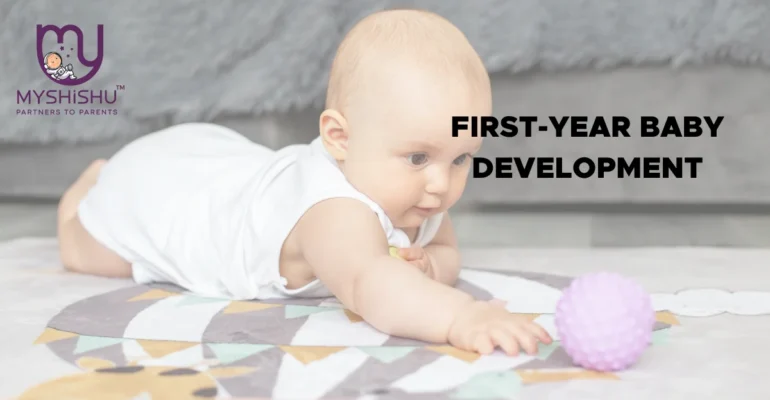First-Year Baby Development: A Comprehensive Guide
First-Year Baby Development: A Comprehensive Guide
Introduction
First-year baby development marks a magical journey filled with extraordinary moments and significant developmental milestones. As parents embark on this exciting adventure, the initial twelve months become a kaleidoscope of rapid changes and awe-inspiring discoveries. This blog is a comprehensive exploration of the multifaceted aspects that define the first year of a baby’s life, shedding light on the physical, cognitive, and emotional advancements that unfold during this remarkable period.
From the first adorable smiles to the joyous moments of witnessing those initial steps, the first year encapsulates a myriad of experiences. Understanding and cherishing these milestones is not only heartwarming but also essential for gaining insights into a child’s developmental trajectory. Join us on this journey as we unravel the intricacies of first-year baby development, offering valuable information, practical tips, and a captivating glimpse into the fascinating world of early childhood growth.
What Is First-Year Baby Development?
The first year of baby development is a transformative period marked by rapid growth and milestone achievements. Physically, infants progress from delicate newborns to curious explorers, mastering essential skills like rolling, sitting, crawling, and, eventually, taking those first wobbly steps. Cognitive development is equally astounding as babies begin to grasp object permanence, babble, and form the foundations of language. Emotionally, the initial bond with caregivers deepens, and social connections start to blossom. This crucial year lays the groundwork for future learning and sets the stage for a lifetime of development, making it a cherished chapter in the parenting journey.
The Journey of First-Year Baby Development: A Comprehensive Guide
The initial year of a baby’s life is a captivating journey marked by remarkable developmental stages. Each phase brings forth unique milestones and discoveries, shaping the foundation for future growth. Let’s embark on a comprehensive exploration of the key stages in the first year of baby development.
1. The Newborn Phase (0–2 Months): Nurturing Fragility
The first two months are a delicate period where the newborn is adjusting to life outside the womb. Basic reflexes like rooting and sucking are crucial for feeding, and the baby begins to recognize familiar voices and faces. While motor skills are in their infancy, parents cherish the early moments of bonding through cuddles and soothing lullabies.
2. The Emergence of Awareness (2-4 Months): Engaging with the Senses
As the baby enters the second quarter, sensory awareness blooms. Eyesight improves, and they start tracking moving objects. The joyous moments of a baby’s first smile often occur during this period, signifying social and emotional development. Tummy time becomes a playful exercise, fostering neck and upper body strength.
3. The Exploration Phase (4-6 Months): Grasping and Rolling
Months four to six unveil a more interactive and curious infant. Hand-eye coordination advances, leading to the delightful development of grabbing objects. Rolling over is a significant motor skill achievement, enhancing spatial awareness. The introduction of solid foods initiates a new chapter in nutritional exploration.
4. Sitters and Babbles (6–8 Months): Achieving Stability
The transition to sitting independently marks newfound stability. Babies engage in babbling, experimenting with sounds and expressions. The first tiny teeth may make their appearance, and dietary preferences evolve. This stage sets the groundwork for later speech development.
5. Crawling into Independence (8–10 Months): Motor Mastery
Crawling signifies a leap in mobility, allowing babies to actively explore their surroundings. Object permanence becomes more apparent as they understand that things exist even when out of sight. A variety of finger foods introduces self-feeding skills, promoting independence.
6. The Advent of First Steps (10–12 Months): Early Walkers
The culmination of the first year often witnesses the thrilling moment of the first steps. Walking, assisted or independently, opens new avenues for discovery. Language comprehension expands, and simple gestures enhance communication. The transition to solid foods progresses, catering to an expanding palate.
Parental Guidance and Nurturing: A Pillar of Support
Throughout these stages, parental involvement remains pivotal. Creating a safe and stimulating environment, offering encouragement, and cherishing each achievement contribute to a secure and happy developmental journey. While every baby is unique, these milestones provide a general framework for understanding and celebrating the extraordinary first year of baby development.

Each Stage of the Month
Month 1: The Newborn Arrival
The initial month is a period of adjustment for both the baby and the parents. Here are the key aspects of development during the first month:
- Motor Skills: limited to reflexes, such as the Moro reflex, which is an automatic response to loud sounds or sudden movements.
- Sensory Development: Developing a preference for high-contrast patterns and focusing on objects at close distances.
- Feeding: Establishing feeding routines, whether breastfeeding or formula feeding, with frequent, small meals.
- Sleep Patterns: irregular sleep patterns with short sleep cycles often prompt night awakenings.
- Social Interaction: There is limited social interaction, with the baby responding to familiar voices and touch.
- Emotional Development: Basic emotional responses, primarily centered around seeking comfort and security.
Month 2: Developing Awareness
As your baby enters the second month, increased awareness and responsiveness become evident.
- Motor Skills: Gradual improvement in head control and the emergence of purposeful hand movements.
- Sensory Development: Growing interest in surroundings, tracking moving objects, and recognizing familiar faces.
- Feeding: Establishing a more predictable feeding routine with longer periods between feeds during the day.
- Sleep Patterns: Slight extension of sleep cycles, with more extended periods of nighttime sleep.
- Social Interaction: Enhanced social responsiveness, with smiles and coos in response to stimuli.
- Emotional Development: Developing a range of emotional expressions beyond basic needs, such as smiling during interactions,
Month 3: Interactive Discoveries
The third month marks a period of increased interactivity and emerging personality traits:
- Motor Skills: improved head control, ability to support the upper body during tummy time, and increased limb movements.
- Sensory Development: Heightened interest in colorful objects, enhanced depth perception, and improved tracking of moving objects.
- Feeding: continued growth patterns, with some babies showing signs of reduced frequency in night feeds.
- Sleep Patterns: longer nighttime sleep stretches, although variations are common.
- Social Interaction: More intentional social smiles, increased cooing, and attempts to engage in two-way communication.
- Emotional Development: Expressing preferences for certain activities or stimuli, showcasing early signs of personal preferences.
Month 4: Exploring the Environment
- Motor Skills: enhanced control of limb movements, increased strength in pushing against surfaces during tummy time, and potential early rolling attempts.
- Sensory Development: Developing a preference for specific textures and fabrics, a heightened response to sounds, and increased visual curiosity.
- Feeding: more efficient feeding with established patterns, and some babies may begin teething.
- Sleep Patterns: Further stabilization of sleep patterns, with the potential for more extended daytime naps.
- Social Interaction: increased responsiveness to voices and external stimuli, turning towards familiar sounds, and showing interest in mirrors.
- Emotional Development: Developing attachment to caregivers, displaying excitement upon seeing familiar faces, and showcasing emotional responses to the environment.
Month 5: Growing Curiosity
The fifth month is characterized by a baby’s growing curiosity and expanding repertoire of expressions.
- Motor Skills: improved ability to roll over, increased control in reaching for objects, and enhanced hand-eye coordination.
- Sensory Development: Heightened interest in colors and patterns, improved ability to locate sounds, and potential early signs of teething.
- Feeding: The introduction of solid foods may be considered, accompanied by continued breastfeeding or formula feeding.
- Sleep Patterns: More extended nighttime sleep, with more predictable sleep cycles.
- Social Interaction: Growing interest in social interactions, potential beginnings of stranger anxiety, and increased responsiveness to facial expressions.
- Emotional Development: Expressing a range of emotions, including joy, frustration, and curiosity, showcases a developing emotional palette.
Month 6: Milestone Achievements
The sixth month is a time of significant milestones, including increased mobility and cognitive advancements.
- Motor Skills: sitting up with support, potential attempts at crawling, and improved coordination in reaching for objects.
- Sensory Development: Heightened interest in exploring objects through touch; potential introduction of solid foods to explore taste.
- Feeding: introduction of a variety of solid foods, with a continued focus on breast milk or formula.
- Sleep Patterns: Establishing more predictable nap schedules and nighttime sleep routines.
- Social Interaction: Enhanced social engagement, recognizing familiar faces, and responding to their own name.
- Emotional Development: Displaying a growing range of emotions, including excitement, joy, and potential expressions of frustration.
Month 7: Developing Independence
- Motor Skills: improved ability to sit without support, potential attempts at crawling, and increased interest in reaching for objects.
- Sensory Development: Growing interest in exploring various textures, tastes, and smells.
- Feeding: further exploration of a variety of solid foods, with increased interest in self-feeding.
- Sleep Patterns: Consolidation of nighttime sleep with established nap routines during the day.
- Social Interaction: Heightened responsiveness to facial expressions, increased babbling, and potential early gestures.
- Emotional Development: Developing a sense of independence, showcasing preferences for specific toys or activities, and displaying a range of emotions in response to various stimuli.
Month 8: Active Exploration
The eighth month is characterized by increased mobility, active exploration, and growing communication skills.
- Motor Skills: crawling becomes more coordinated; potential attempts at pulling up to a standing position; and enhanced fine motor skills.
- Sensory Development: Exploring objects through various senses increases responsiveness to music and rhythm.
- Feeding: growing interest in self-feeding, with a continued focus on a balanced diet.
- Sleep Patterns: Consistent nighttime sleep, with established nap routines during the day.
- Social Interaction: Increased babbling, potential imitation of simple gestures, and growing interest in interactive games.
- Emotional Development: Developing a sense of humor, showcasing joy through laughter, and expressing clear likes and dislikes.
Month 9: Language Development
The ninth month brings notable advancements in language development and increased interaction with the environment.
- Motor Skills: pulling up to stand becomes more stable; cruising along furniture; and potential early attempts at independent steps.
- Sensory Development: Growing interest in exploring the environment, heightened responses to familiar voices, and increased awareness of their name.
- Feeding: transitioning to more textured foods, growing independence in holding and exploring food items.
- Sleep Patterns: Establishing consistent nap routines with more prolonged periods of nighttime sleep.
- Social Interaction: Increased interest in interactive games, potential understanding of simple commands, and growing responsiveness to emotional cues.
- Emotional Development: Expressing a wider range of emotions through sounds and gestures, showcasing growing independence and preferences.
Month 10: Enhanced Mobility and Communication
The tenth month is marked by enhanced mobility, increased communication attempts, and growing independence.
- Motor Skills: enhanced cruising along furniture, increased stability in standing, and potential early attempts at independent steps.
- Sensory Development: Exploring objects with increased curiosity, recognizing familiar faces, and responding to a variety of sounds.
- Feeding: Continued progress in self-feeding, with an interest in a wider variety of tastes.
- Sleep Patterns: extended periods of nighttime sleep, with established nap routines during the day.
- Social Interaction: Growing interest in interactive play, attempts at simple gestures like waving, and increased engagement in games like peek-a-boo.
- Emotional Development: Developing a sense of empathy, showcasing preferences for specific toys or activities, and expressing emotions through gestures.
Month 11: Advanced Communication
The eleventh month is characterized by advanced communication attempts, increased exploration, and continued development of fine motor skills.
- Motor Skills: increased confidence in standing, potential attempts at independent walking, and enhanced fine motor skills like pincer grasp.
- Sensory Development: Exploring the environment through touch, taste, and sight, with a growing interest in cause-and-effect relationships.
- Feeding: transitioning to a more varied diet, with increased attempts at self-feeding using fingers.
- Sleep Patterns: Consistent nighttime sleep, with established nap routines during the day.
- Social Interaction: Advanced attempts at imitating sounds and simple words, growing interest in social games, and increased responsiveness to verbal cues.
- Emotional Development: Demonstrating preferences for specific people or toys, showcasing a range of emotions through facial expressions, and developing a sense of humor.
Month 12: Milestones and Celebrations
The twelfth month marks a significant milestone as the baby completes the first year, bringing a culmination of developmental achievements:
- Motor Skills: advanced mobility, with potential independent walking, cruising along furniture with ease, and increased coordination in movements.
- Sensory Development: Heightened awareness of the environment, increased recognition of familiar faces and objects, and growing curiosity about the surrounding world.
- Feeding: Transition to a more varied diet, with increased self-feeding using utensils and developing preferences for certain tastes.
- Sleep Patterns: Consistent nighttime sleep, with established nap routines during the day.
- Social Interaction: Advanced communication attempts, potential early words, and increased engagement in interactive play.
- Emotional Development: Developing a stronger sense of self, showcasing a variety of emotions, and forming secure attachments to caregivers.
When to see the Pediatrician
During the first year of a baby’s development, regular check-ups with a pediatrician are crucial to monitor growth, address concerns, and ensure overall well-being. The American Academy of Pediatrics recommends a schedule of well-baby visits at 1, 2, 4, 6, 9, and 12 months, with additional visits as needed. These visits typically involve assessments of growth, developmental milestones, vaccinations, feeding practices, and any parental concerns.
However, it’s essential to recognize that every baby is unique, and individual needs may vary. Immediate attention from a pediatrician is warranted if there are signs of illness, unusual behavior, or parental concerns about the baby’s health. Regular communication with the pediatrician fosters a collaborative approach to the baby’s care, providing parents with guidance, reassurance, and the necessary information for promoting a healthy and thriving first year of development.
Conclusion
Embarking on the journey of a baby’s first year of development is an extraordinary experience filled with growth, milestones, and cherished moments. Each stage, from the initial moments of cuddles to the first steps, contributes to a unique and beautiful tapestry of parenthood. Navigating the intricacies of development, from physical milestones to emotional bonds, requires patience, knowledge, and a deep understanding of the individuality of each baby. By fostering a nurturing environment, staying informed, and seeking professional guidance when needed, parents can create a foundation for a healthy, happy, and thriving first year for their little ones.










